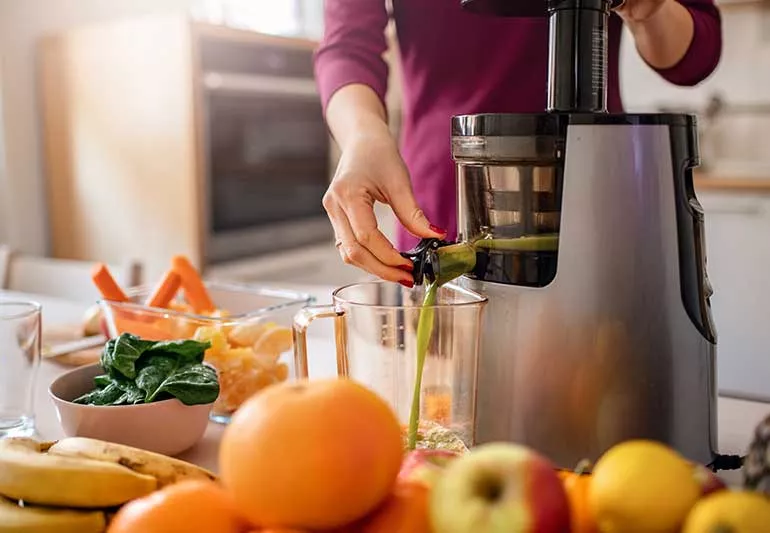In today’s health-conscious world, fresh fruit juices have become a daily habit for many. However, the appliance you choose plays a key role in the quality and nutritional value of your juice. Deciding between a slow juicer and a hand blender can make all the difference.
Here, we explore the benefits and differences of these appliances and how to choose the best one for your juicing needs.
What’s the Difference Between a Slow Juicer and a Blender?
A slow juicer or cold-press juicer operates at a low speed and utilises gentle pressure to extract juice. This method produces minimal heat, which helps preserve essential nutrients. The result of slow juicing is a smooth, pulp-free juice with great taste and freshness.
On the contrary, a hand blender uses high-speed blades to blend the entire fruit, including pulp and fibre, into a thick, smoothie-like consistency. While convenient and quick, this method leads to faster oxidation and nutrient loss. The main differences involve texture, nutrition, and extraction techniques.
Health & Nutritional Benefits: Slow Juicer vs Blender
The way your appliance processes ingredients significantly affects the nutritional quality of your drink.
Slow juicers operate at low speeds, which generates minimal heat. This method minimises oxidation of the nutrients, thereby preserving vital nutrients, vitamins, enzymes, and antioxidants. This kitchen appliance is ideal for individuals who are health-conscious.
In comparison, hand blenders use high-speed blades that introduce heat and air, which can accelerate the degradation of nutrients. However, they retain all the fibre, which aids digestion and helps you feel full longer.
While slow juicers are better for nutrient retention, blenders are a great choice when fibre and thicker textures are preferred.
Slow Juicers: Pros and Cons
Pros:
- Better nutrient retention: Cold-press technology minimizes heat and oxidation, preserving vitamins, enzymes, and antioxidants.
- Higher juice yield: Extracts more juice from the same amount of ingredients, leaving dry pulp behind.
- Ideal for a variety of ingredients: Efficiently processes leafy greens, hard fruits, and even nuts for nut milk.
- Longer shelf life: Juice from a slow juicer stays fresh longer due to reduced oxidation.
- Smooth, pulp-free texture: Produces clean, foam-free juice with a pleasant consistency.
Cons:
- Longer prep time: Ingredients may need to be cut into smaller pieces before juicing.
- More cleanup required: It comes with multiple parts that need to be cleaned after use.
- Takes up more counter space: Generally bulkier than a hand blender.
Hand Blender: Pros and Cons
Pros:
- Quick and convenient: Ideal for busy routines, so just plug in, blend, and you’re done.
- Multipurpose use: Great for making smoothies, soups, lassi, batters, and other kitchen tasks.
- Retains fibre: Blends whole fruits and vegetables, keeping all the natural fibre for better digestion and prolonged satiety.
- Easy to clean: With fewer detachable parts, cleaning is faster and simpler.
- Compact design: Lightweight and space-saving, suitable for small kitchens.
Cons:
- Not ideal for pure juices: Blended drinks are thicker and may require straining for a smoother texture.
- Higher oxidation: High-speed blending can introduce heat and air, reducing nutrient stability.
- Limited performance with certain ingredients: Not effective for juicing hard fruits, leafy greens, or nuts.
Which Should You Choose? Slow Juicer or Blender?
The choice between a slow juicer and a hand blender depends on your lifestyle, dietary goals, and personal preference for juicing.
For nutrition and to enjoy clear, pulp-free juice, a slow juicer is a better option. It’s ideal for those committed to daily juicing, detox routines, or incorporating leafy greens and hard fruits into their diet.
If convenience and versatility are your top priorities, a hand blender may be the right choice. It blends quickly, retains fibre, and works well for smoothies, soups, and other recipes.
Both kitchen appliances offer distinct advantages, and Wipro delivers reliable, high-performance options in both categories.
Introducing Wipro Appliances
The Wipro Vesta Cold Press Slow Juicer is a modern kitchen appliance that is efficient and powerful. This kitchen appliance is for those who prioritise nutrition. Equipped with a 240W copper DC motor and operating at a slow 55 RPM, it ensures maximum juice extraction with minimal nutrient loss. The dual-feeding chute easily handles both whole fruits and leafy greens. It also includes a reverse function, is easy to clean, and comes with attachments for nut milk and sorbet. Made from BPA-free, food-grade materials, this slow juicer delivers superior performance.
For versatile blending, the Wipro Hand Blender 300 Watt delivers silent, high-performance operation. With a hybrid blade and stainless steel stem, it’s perfect for making smoothies, soups, and everyday recipes.
Conclusion
Your lifestyle and health preferences should be your top priority when selecting the right kitchen appliance for yourself. A slow juicer is ideal for nutrient-rich, pulp-free juice, while a hand blender offers a fast, fibre-rich option for smoothies and more. With Wipro’s range of innovative kitchen appliances, you can enjoy healthier, more efficient juicing every day. Discover the perfect kitchen appliance for your unique needs.

